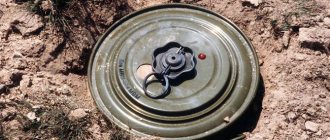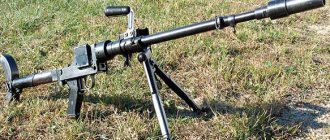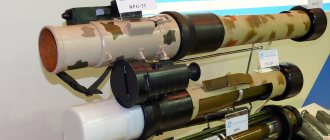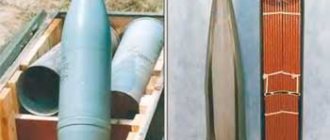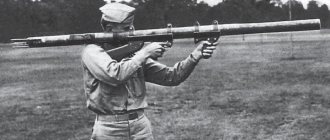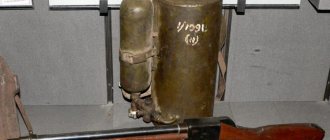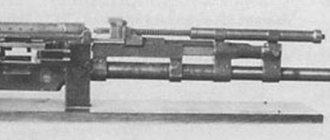Mine weapons are one of the main types of engineering weapons. This weapon became especially relevant when heavy armored vehicles and other vehicles appeared in armies. To combat enemy armored vehicles, perhaps the most convenient means of anti-tank defense is an anti-tank mine. A correctly placed high-explosive charge can not only disable a tank or armored personnel carrier. Minefields can become an insurmountable barrier for enemy mechanized units, preventing an offensive in the most threatened areas of the confrontation.
Mine weapons become the main means of defense
Initially, the mine in the form in which we are accustomed to perceiving this weapon did not arouse much enthusiasm among the military. Mine weapons were mainly used for engineering purposes to break through strong enemy defensive formations and to destroy long-term defensive fortifications. Only with the advent of mechanized weapons did mines begin to be used more purposefully.
Warships were the first to become familiar with mine weapons. The installation of mines along the route of military ships jeopardized all existing transport communications. The Russo-Japanese War was the first armed conflict during which mines were widely used. The results were stunning. More than 20% of all warships of the warring parties were sunk by mines. The mine could easily cripple any large warship. From that moment on, the mine became firmly established in the arsenal of all navies, becoming an essential element of naval defensive strategy.
In the land theater of operations, mines began to be actively used during the First World War. When the first armored vehicles began to appear on the battlefield, we had to remember about mine weapons. At that time, high-explosive mines were used, capable of causing serious destruction to ground objects with the explosion of a powerful TNT charge. The division of mine weapons into anti-tank and anti-personnel mines occurred much later, when the need arose to create an effective engineering means of deterring offensive actions. Long-term defensive lines that emerged on the borders of France and Germany, on the Soviet Western border and on the borders between Finland and the Soviet Union included large-scale minefields. The emphasis was on laying high-explosive charges capable of containing mechanized and mobile formations. At first these were object land mines, anti-vehicle mines that did not have a clearly defined purpose. As a rule, such charges were triggered by a simple mechanical impact on the fuse, or were activated by an electrical discharge.
A full-fledged service anti-tank mine TM appeared in the early 30s. In Germany and the USSR, the creation of this weapon was treated with interest. The whole point is that it was the military doctrine of Nazi Germany and the Soviet Union that assumed the massive use of armored formations during a military conflict. It was possible to withstand the attack of armored vehicles only with the help of effective anti-tank defense. Anti-tank mines became one of the most important elements of such defense.
The beginning of the 30s was marked by active work to create new types of mine weapons capable of hitting all types of armored vehicles.
Military engineering mechanization
The Third Reich's experiments in aerial mining during the war were premature, which is why they did not prove to be as effective. The design of mines at that time was not reliable enough, and lost air superiority did not allow the active use of this method of laying minefields. It is not surprising that the post-war development of mine weapons did not immediately lead to mechanization.
Soviet minelayer of the third generation UMZ.
The stage of mechanization of mine installation began only in the early 1960s. The initial approach, somewhat tested during the war, was to some extent a blind copying of naval methods - so-called mine spreaders were created. The simplest spreaders were wooden trays attached to the rear side of the car (the Soviet PMR-2 differed only in that it was metal). The mines laid out on the ground were manually equipped with fuses, transferred to the firing position and camouflaged.
The PMR-3 trailed minelayer already provided for the automatic placement of mines with a given mining pitch, their transfer to a firing position and even camouflage with soil. For this minelayer, a new anti-tank mine TM-57 was developed, equipped with the same new MVZ-57 fuse. Automation of mining was achieved due to the fact that immediately before installing the mine on the ground, the minelayer mechanism pressed a button that triggered the fuse clock mechanism. A few minutes after installation, the mine was transferred to the firing position.
Three PMR-3 minelayers, each of which held 200 mines, laid out a three-row minefield about 800 meters along the front, spending less than an hour on it.
The next step was the GMZ tracked minelayer designed by G. S. Efimov, created on the basis of the SU-100P self-propelled gun (aka “Object 118”). He was capable of laying a kilometer-long minefield in 10-15 minutes. This result was already a very serious achievement.
Cassette for the VMR helicopter mine spreader, equipped with PFM-1 mines.
This is interesting:
The GMZ minelayer of later modifications had additional weapons - six grenade launchers of the 902B "Tucha" smoke screen system, designed to fire 81-mm smoke grenades.
In the matter of mechanization of laying minefields, the Soviet Union was a good ten years ahead of its potential enemy. Similar vehicles entered service with the US Army only in 1972. Great Britain acquired minelayers a little earlier - in 1969, and France - only in 1977. Such a temporary oversight on the part of a potential enemy seems inexplicable and somewhat strange, given that the official military doctrine of the USSR at that time relied heavily on the rapid movements of armored forces.
The United States made a significant breakthrough in operational anti-tank mining technology in 1973, when the first full-fledged helicopter system entered service, which included a UH-1H helicopter with two bomb clusters suspended from it. One cassette contained 80 M56 anti-track mines.
Development of mine weapons in the USSR
Officially, the first anti-tank mine appeared in the USSR in 1934. There was no need to talk about the complex design of the explosive device. The main charge was a set of TNT blocks, which were activated by a pressure fuse. The product, after a series of tests, was not widely used. It was replaced in 1935 by a more advanced design - the TM-35 anti-tank mine. This product has already been made thoroughly and thoughtfully. A TNT charge weighing 2.8 kg was enclosed in a steel case. The mine was installed manually, in almost any type of soil. The mine was activated using a universal fuse.
Created in 1935, the MUV fuse had a simple and reliable design, thanks to which it continues to be used today. A serious advantage that this type of fuse had was the technical ability to neutralize a mine. Having installed a safety sleeve or pin on the fuse rod, it was possible to begin demining.
Just before the war, the Soviet mine went through a stage of modernization, as a result of which the tactical and technical characteristics of the device were improved. The mine could be installed not only in the ground, but also in water, to a shallow depth. The operating principle of the device was as follows. When a wheel or track of a vehicle collided with the fuse cover, the main charge was triggered. As a result of the explosion and high-explosive action, the chassis of the vehicle was destroyed. In the pre-war period, Soviet military engineers tried to use the experience of the Soviet-Finnish conflict, during which Soviet armored units suffered significant losses from mine weapons. Anti-tank mines with anti-track and anti-bottom action appear in service with the engineering and sapper units of the Red Army. This weapon was capable of hitting the bottom of a vehicle with an explosion, completely incapacitating it and its crew.
Before the start of the Great Patriotic War, the arsenal of engineering and technical equipment of the Red Army included the following types of mine weapons:
- anti-tank mine TM-39;
- anti-tank mines PMZ-40 and TMD-40;
- anti-tank mine AKS;
- anti-personnel mines PMK-40, PPM-6 and the POZM mine - fragmentation ammunition.
All mine weapons equipped by the Red Army were equipped with fuses of various effects. These could be delayed-action detonators, blasting caps, tension or push-action fuses. Soviet military engineers achieved particular success in the design of remote fuses and electric detonators. Enormous credit for the creation of Soviet mine weapons, which the Wehrmacht units had to come face to face with, belongs to General D.M. Karbyshev.
The Soviet Union actively used mine weapons during the Great Patriotic War. Soviet anti-tank mines were most widely used in 1942-43, during the period of the most active hostilities on the Soviet-German front. The Battle of Kursk became the apotheosis of mine weapons. The German tank formations suffered the greatest losses as a result of explosions on anti-tank landmines. In the following months, due to the beginning of a full-scale offensive by Soviet troops along the entire front line, the intensity of the use of anti-tank and anti-personnel mines decreased.
In total, during the war years, Soviet military engineers and sappers installed more than 70 million mines for various purposes.
In the period 1941-42, the average density of minefields was 200-600 mines per kilometer of front. In 1943, this value reached its maximum - 800 mines per kilometer section of the front.
A huge number of mines remained in army warehouses after the end of World War II. A certain number of anti-tank mines were used to equip the state border in Central Asia, Transcaucasia and the Far East. The TM 57 anti-tank mine replaced the outdated models of mine weapons inherited during the Great Patriotic War in 1957. This weapon had a main charge weight of 6.5 kg and could be installed in the ground, in snow cover or under water. The mine was the first engineering tool that could be installed manually or mechanized. The combat operation of the new design of mine weapons had no time limits.
Following the TM-57 mine, a new weapon entered service with the Soviet Ariya in 1962. It was a more advanced passive ammunition, having a practical and versatile design. The device was activated by a pressure fuse. The installation of the mine could be done manually or mechanized. The main charge was 7.5-8 kg. TNT, TGA or MS. The TM 62M anti-tank anti-track mine - this engineering and technical device continues to be in service today, being perhaps the only passive means of organizing anti-tank defense.
Design[edit]
More modern anti-tank mines are usually more advanced than simple containers filled with explosives detonated remotely or by vehicle pressure. The greatest successes have been achieved in the following areas:
- The power of explosives (such as RDX).
- Shaped charges to increase armor-piercing effect.
- Advanced spray systems.
- More advanced or specific detonation triggers.
Most modern mine casings or casings are made of plastic to prevent them from being easily detected. They use combinations of pressure- or magnetic-activated detonators to ensure they are only triggered by vehicles.
Wehrmacht anti-tank weapons
Like the USSR, Germany entered the war with a limited number of mine weapons. The emphasis in the new armed conflict was on attacking actions, so engineering and special weapons remained in the background. Later, when the Wehrmacht faced fierce resistance from the Red Army, when Soviet troops began to take counterattacking actions, the Germans had to resort to mine weapons.
The history of the development of mines in Germany is identical to the processes occurring in the Soviet Union. Back in 1929, the German anti-tank mine Tellermine 29 was created. Later, with Hitler coming to power, German military engineers began work on creating anti-personnel and anti-tank mines. Unlike Soviet weapons, where the main anti-tank mine TM had a powerful high-explosive charge and a pressure-action fuse, German explosive devices carried a smaller main charge. However, the number of fuses was increased to three, which increased the likelihood of the ammunition going off.
By the beginning of hostilities, the Wehrmacht's arsenal of mine weapons was not very diverse. Only in 1943, after the beginning of a radical change in military operations on the Eastern Front, the German army began to receive anti-tank and anti-personnel mines in huge quantities. German minefields were laid in the most likely areas for a breakthrough by Soviet armored units. However, the advent of mechanized mine clearance equipment in the Soviet Army made it possible to successfully overcome this obstacle.
Off-road mines[edit]
Polish MPB mine.
Off-road mines are designed to be effective when detonated next to a vehicle rather than under it. They are useful in cases where the ground or surface is not suitable for burying or covering mines. They typically use a Mishnei-Shardin shaped charge to fire a penetrating bullet through a target's armor. This self-loading principle was used in some French and Soviet off-road mines and became notorious as an improvised explosive device (IED) technique in Israel and especially Iraq.
How to use the American M-24 anti-tank mine
Due to the critical standoff required for penetration and the development of standoff neutralization technologies, off-route shaped charge mines using the Munroe effect are less common, although the British/French/German tandem warhead ARGES mine is an example of one of the more successful ones.
The term "off-road mine" refers to specially designed and manufactured anti-tank mines. Explosive-fired projectiles (EFP) are one type of IED that was used in Iraq, but most improvised IEDs are not used in this way.
Eventually
Mines, as a passive weapon, continue to remain in the arsenal of all modern armies. Thanks to these weapons, the weaker side of the conflict is able to hold back the offensive impulse of the strongest enemy. This was perfectly demonstrated during the Arab-Israeli wars and during the Gulf War. Huge minefields significantly limited the action of coalition troops in Kuwait and southern Iraq. Unlike other weapons, mines continue to be dangerous even after a long time. To this day, armed anti-tank and anti-personnel mines continue to be found in areas of the most intense fighting during armed conflicts.
Countermeasures[edit]
Main article: Demining
The most effective countermeasure against minefields is mine clearance using explosive or mechanical methods. Explosive techniques, such as the Giant Viper and the SADFPlofadder 160 AT, involve planting explosives through a minefield, either by throwing the charges across the field using missiles or by dropping them from an aircraft, then detonating the explosive to clear the path. Mechanical methods include plowing and pressure detonation. When plowing, a specially designed plow attached to the front of a heavily armored tank is used to push away the earth and any mines embedded in it, clearing a path as wide as the pushing tank. When detonated under pressure, a heavily armored tank pushes a heavy spherical or cylindrical metal roller forward, causing the mines to explode.
Personnel carrier Casspir
There are also several ways to make vehicles resistant to the effects of mines to reduce the likelihood of crew injury. In the case of a mine explosion, this can be achieved by absorbing the energy of the explosion, deflecting it away from the body of the vehicle, or increasing the distance between the crew and the points where the wheels touch the ground - where any explosions are most likely to be concentrated.
A simple and very effective way to protect the occupants of a wheeled vehicle is to fill the tires with water. [3] This will have the effect of absorbing and deflecting the mine's explosion energy. The steel plates between the cab and wheels can absorb energy and are more effective if they can be tilted to deflect it away from the cab. Increasing the distance between the wheels and the passenger compartment, as done on the South African Casspir Armored Personnel Carrier, is an effective technique, although there are problems with mobility and ease of driving with such a vehicle. A mine-resistant vehicle may use a wedge-shaped passenger cabin with the thin edge of the wedge down to divert blast energy away from the occupants. Homemade measures such as sandbags in the floor of a car or bulletproof vests placed on the floor can provide some protection from tiny mines.
Steel plates on the floor and sides, as well as armored glass, will protect passengers from fragments. Mounting seats on the side or roof of the vehicle rather than on the floor will help protect occupants from impacts transmitted through the vehicle's structure, and a four-point seat belt will minimize the chance of injury if the vehicle is thrown on its side. or its roof - a mine can throw a vehicle at a distance of 5-10 m from the point of explosion.
Police and military can use the robot to remove mines from an area. [4]
Links[edit]
- "The Origins of War Mines: Part II". Engineer's Bulletin. November 1998. Retrieved December 31, 2008. Quote journal requires |journal=(help)
- Barrett Haseltine; Christopher Bull (2003). Field Guide to Related Technology. Academic press. item 853. ISBN. 978-0-12-335185-2.
- "A Study of Mechanical Applications in Mine Clearing" (PDF). Geneva International Center for Humanitarian Demining. 2004. Archived from the original (PDF) on September 28, 2007. Retrieved July 23, 2007. Quote journal requires |journal=(help)
- https://www.army-technology.com/projects/uran-6-mine-clearing-robot/
- David M. Glanz (1986). "Soviet defensive tactics near Kursk, July 1943." US Army Command and General Staff College: 19. OCLC 320412485. Quote journal requires |journal=(help)
- "RUSSIAN ANTI-TANK TACTICS, January 1943" . Lonely sentinel. 2007-05-10. Retrieved October 23, 2015.
- Peter Darman (2012). The Allied Invasion of Europe. Publishing group "Rosen". pp. 8–9. ISBN 978-1-4488-9234-1.
- ↑
About the losses of Allied tanks in foreign economic activity and German anti-tank guns - ↑
An anti-tank mine killed 7 Cambodian sappers.
See also[edit]
- Mining Advisory Group
- Swiss Foundation for Mine Action (FSD)
- List of landmines (contains details of different types)
- Explosion-resistant mine
- Tamper protection device
Examples of anti-tank mines
- Type 72, China (modern)
- Tellermain, German (World War II era)
- Topfmine German (World War II era)
- Rudnik TM-83, Russia (modern) off-road mine using the Michelney-Chardin effect
- ARGES mine, off-piste mine Austria
- Mine FFV 028, Sweden
- ATM 2000E, Austria
- VS-HCT Mine, Italy
Mine expansion systems
- GEMSS shaft system
- GATOR mine system
- Volcano mine system
